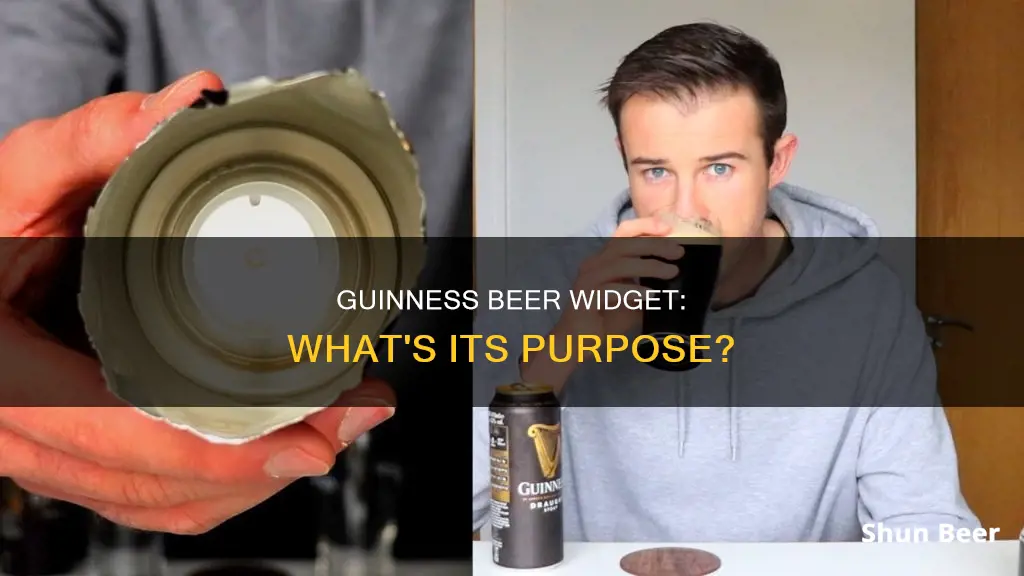
The widget in Guinness beer is a tiny, plastic ball placed inside beer cans to give the brew its signature creamy head. The widget was developed by Guinness in 1969 and released in 1989. During the canning process, brewers add liquid nitrogen to the beer, which quickly evaporates and creates pressure inside the can. When the can is opened, the gas and liquid leave the widget, mixing with the beer and creating a foamy head. The widget in Guinness cans is not filled with nitrogen, but the nitrogenated beer inside the widget is released when the can is opened, creating the desired effect.
What You'll Learn

The widget's function
The widget in Guinness beer is a tiny device that replicates the draught experience in a can, giving the beer a silky, creamy head. The widget was developed by Guinness in 1969 and debuted in 1989. It is a small, hollow, spherical piece of food-grade plastic with a tiny hole in it, similar in appearance to a ping pong ball. During the canning process, brewers add liquid nitrogen to the beer before sealing the can. The liquid nitrogen quickly evaporates, creating pressure inside the can. This pressure forces gas and liquid into the widget, filling it with pressurised gas and beer.
When the can is opened, the pressure in the can drops, causing the gas and beer inside the widget to jet out from the hole. This agitates the surrounding beer, creating a chain reaction of bubble formation. When the can's contents are poured into a glass, the result is a surging mixture of very small gas bubbles and liquid, creating a creamy head. This process is time-sensitive, and the beer should be poured immediately after opening the can to achieve the desired effect.
The widget was designed to address the challenge of producing draught-style Guinness in cans or bottles. Initially, Guinness brewers developed a system involving an "initiator" device that resembled a syringe, but this approach was not actively marketed internationally. The widget provided a solution by releasing a surge of bubbles when the can is opened, mimicking the draught experience.
The first-generation widget, released in 1989, was a flattened disc that sat at the bottom of the can. While it performed well when the beer was served cold, it could cause overflow if the beer was warm. In 1997, Guinness introduced the floating widget, also known as the "Smoothifier," which resolved this issue. This floating widget can be found in cans of Guinness today and has contributed to the consistent, creamy head that characterises the brand.
Guinness Blonde Ale: Wheat Beer or Not?
You may want to see also

How it works
The widget in Guinness beer is a small, hollow, spherical piece of food-grade plastic with a tiny hole in it, similar in appearance to a ping pong ball. It was developed by Guinness in 1969 and first released in 1989 to give their canned brews a silky, creamy head.
During the canning process, brewers add liquid nitrogen to the beer immediately before sealing it. The liquid nitrogen quickly evaporates in the container. But since the can is sealed, this creates pressure inside, forcing gas and liquid into the widget through its tiny hole.
Then, when you open the can, you should hear a "pssshhh" sound. This is the gas and liquid leaving the widget, which mixes with the beer, creating a foamy head. This is the signature creamy head that's iconic to a Guinness draft.
For canned Guinness, you should pour the beer into a glass after opening, but the bottle widget (which is shaped like a rocket) is designed for you to enjoy straight from the bottle.
The widget in the base of a beer glass works by creating a nucleation point, allowing the CO2 to be released from the liquid that comes into contact with it, thus assisting in maintaining the head on the beer.
Guinness Beer: The Mystery of the Plastic Ball
You may want to see also

The history of the widget
The widget has played a pivotal role in the history of Guinness, allowing the brand to recreate the draught experience in a can. The widget's journey began in 1969 when two Guinness brewers at the St James's Gate Brewery in Dublin, Tony Carey and Sammy Hildebrand, developed a system to produce draught-type Guinness from cans. They patented the idea of using an internal compartment to discharge gas, but technical difficulties meant this approach was put on hold.
In 1984, under the direction of Alan Forage, work restarted on the widget. The plan was to introduce a plastic capsule into the can, pressurise it during filling, and then release the pressure in a controlled manner when opened. This would create the characteristic creamy head associated with Guinness. However, Tony Carey noticed that beer was forced into the widget during pressurisation, reducing the head quality. He suggested inverting the can after sealing to solve this issue, and the innovation proved successful.
The first-generation widget, a plastic disc held in place by friction at the bottom of the can, was released in 1989. While it worked well with cold beer, it caused overflow when the beer was served warm. To address this, Guinness introduced the floating widget, or "Smoothifier", in 1997. This spherical widget effectively releases nitrogen into the beer upon opening, creating a surge of bubbles and a smooth, velvety texture. The floating widget also eliminated the issue of overflow, ensuring a perfect pour every time.
The widget has been a magical innovation for Guinness, so much so that in 2004, a survey of almost 9,000 people voted it a greater invention than the internet!
Guinness: Beer or Lager? Understanding the Dark Irish Drink
You may want to see also

Guinness' innovation
Innovation has been at the heart of Guinness since its inception. In 1801, Arthur Guinness kickstarted the brand's innovative spirit by creating its first major innovation, West India Porter. Arthur wanted to export his beer to countries like the West Indies, so he developed a preservation method by creating a recipe with a high alcohol and hops content, resulting in a more intense beer that could preserve itself during long overseas journeys.
Guinness has continued to push the boundaries in the world of brewing, with a dedication to innovation that has remained key to its success. One of its most notable inventions is the widget, a tiny device placed inside beer cans to manage the characteristics of the beer's head. The widget was patented in Ireland by Guinness and debuted in 1989 with its first-generation widget, a flattened disc at the bottom of the can. However, this design had a flaw, as it caused the beer to overflow when served warm.
To address this issue, Guinness released the floating widget, also known as the "Smoothifier," in 1997. This new widget is a hollow, spherical piece of food-grade plastic with a tiny hole, resembling a miniature ping pong ball. During the canning process, brewers add liquid nitrogen to the beer before sealing it. The liquid nitrogen quickly evaporates, creating pressure inside the can. This pressure forces gas and liquid into the widget through its small hole. When the can is opened, the gas and liquid escape from the widget, mixing with the beer and creating a foamy head, reminiscent of a fresh draft.
The widget's purpose is to replicate the draught experience in a can, giving Guinness beer its signature creamy head and smooth, velvety texture. It achieves this by slowly releasing nitrogen into the beer upon opening, creating smaller bubbles that increase the creaminess of the head. This innovation was so well-received that it won the Queen's Award for Technological Achievement in 1991.
Guinness' commitment to innovation extends beyond the widget. They were the first to introduce nitrogen to beer, revolutionising the way it is served and transforming the beverage itself. Additionally, they built the MV Miranda Guinness in 1977, the world's first bulk liquid carrier, specifically commissioned to transport Guinness from Dublin to the UK. Guinness continues to push boundaries, recently mastering the alcohol-free pint and the MicroDraught keg, demonstrating their unwavering dedication to innovation and improving the drinking experience for their customers.
Guinness Beer: German or Irish?
You may want to see also

Other beers with widgets
The widget in Guinness beer is a tiny, plastic ball inside the can. It was developed by Guinness in 1969 and first released in 1989 to give their canned brews a silky, creamy head. During the canning process, brewers add liquid nitrogen to the beer immediately before sealing it. The liquid nitrogen quickly evaporates, creating pressure inside the can. This forces gas and liquid into the widget through its tiny hole. When the can is opened, the widget's nitrogenated beer squirts into the rest of the beer, creating a foamy head and giving it a velvety texture.
- Young's Double Chocolate Stout
- Murphy's Stout
- Boddington's Pub Ale
- John Smith's Smooth Ale
- Bellhaven Scottish Ale
- Old Speckled Hen
- Wexford Irish Ale
- Tetley's Smooth Flow
The widget in these beers works in the same way as the one in Guinness, creating a creamy head and a smooth taste. These beers are all from the UK and Ireland, where beers have considerably less carbonation than American beers. This means that when they are bottled or canned, they often lack a head when poured. The widget solves this problem by creating a surge of bubbles when the can is opened, replicating the draught experience.
The Cost of Guinness Beer in Ireland
You may want to see also
Frequently asked questions
A widget is a small device placed inside a beer can to manage the characteristics of the beer's head.
The widget in Guinness beer is a tiny, hollow, spherical piece of food-grade plastic with a tiny hole in it. It gives the beer its signature creamy head, similar to the two-part pour you get at a pub.
During the canning process, brewers add liquid nitrogen to the beer immediately before sealing it. The liquid nitrogen quickly evaporates in the container, creating pressure inside the can. This forces gas and liquid into the widget through its tiny hole. When the can is opened, the gas and liquid leave the widget and mix with the beer, creating a foamy head.
The widget in Guinness beer looks like a small white ball, similar to a ping pong ball.
Guinness brewers first patented the idea of the widget in 1969. However, it wasn't until 1989 that they released their first-generation widget.







